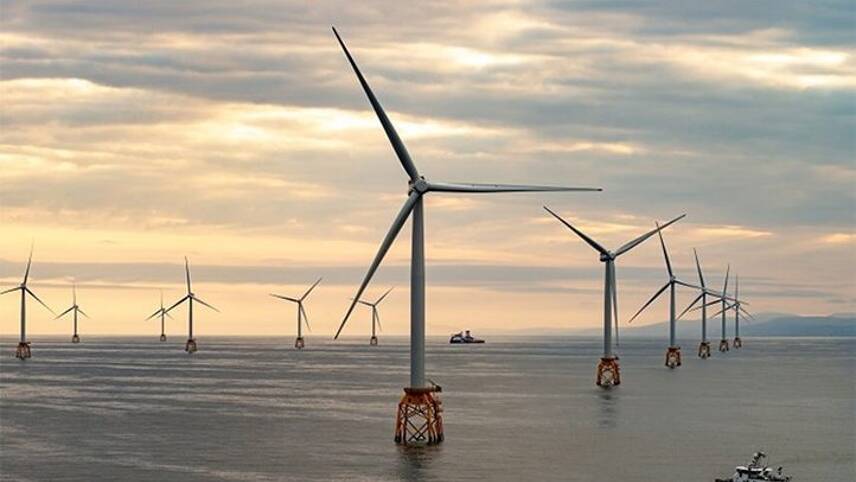Register for free and continue reading
Join our growing army of changemakers and get unlimited access to our premium content

Image: SSE
The Department for Business, Energy and Industrial Strategy has today (25 Jan) announced the 11 projects it has selected to receive grant funding through its Floating Offshore Wind Demonstration Programme, funded through the Treasury’s £1bn Net-Zero Innovation Portfolio.
Each selected project will also receive funding from the private sector. In total, the 11 projects are receiving £61.4m of new investment.
The largest sum, £10m, is going to a consortium project working to pilot a 2MW or larger turbine in UK waters. Involved in this project are the Offshore Renewable Energy Catapult, SenseWind, Geodis FF and Xodus Group. Floating wind supporters often say one of the solutions’ biggest advantages is that it can enable larger turbines to be built in deeper waters, thus maximising generation.
As well as working to produce bigger turbines, the selected projects are working to overcome other challenges with floating wind technologies, including reducing installation and maintenance times and costs; connecting them to cabling systems and improving the material efficiency of anchoring systems.
BEIS is badging the funding, in its media coverage of the funding, as part of its solution to the ongoing energy price crisis. Wholesale gas and electricity prices in the UK are more than twice as high as they were in January 2021, due to numerous challenges with importing gas.
“We are already a world leader in offshore wind and floating technology is key to unlocking the full potential of the seas around Britain,” said Energy Minister Greg Hands. “These innovative projects will help us expand renewable energy further and faster across the UK and help to reduce our exposure volatile global gas prices.”
The news from BEIS comes a week after Crown Estate Scotland announced the successful bidders under its 2022 ScotWind Auction, which marked the first time in a decade that plots of Scottish seabed were auctioned to renewables developers. That Auction round selected projects with a total proposed capacity of 24.8GW, of which 16GW is floating wind.
Separately, the UK Government opened the fourth round of its Contracts for Difference (CfD) auction scheme in December 2021, with the aim of supporting 12GW of new generation capacity. Offshore wind will be supported, as it always has been – but for the first time in several years, there are also allocations for onshore wind, solar and tidal.
All of these announcements follow on from a commitment for the UK to deliver an entirely “clean” electricity system by 2035. This will mean ending generation from unabated gas and scaling generation from renewables and nuclear.
Green economy reaction
Responding to today’s announcement on floating offshore wind funding, the Aldersgate Group’s executive director Nick Molho said: “Following on from the significant amount of offshore wind projects selected at the ScotWind Leasing round last week, this announcement is a reminder of how long-term targets and stable policy support can accelerate innovation across the renewables industry.
“Building on the jobs already created by the offshore wind sector in areas such as Hull, the Solent and Scotland, the geographic spread of the projects receiving innovation funding today highlights that the renewables sector – and low carbon industries more broadly – can drive investment and job creation in multiple parts of the country and be a key part of the levelling up agenda.”
RenewableUK’s chief executive Dan McGrail added: “Today’s announcement will help the UK to develop floating wind technology faster and bring down costs for consumers. The UK is currently the biggest market in the world for this cutting-edge technology and other countries are following our lead. Investing in innovation is vital to build up a UK supply chain that can meet the needs of our domestic market and seize the global opportunities that floating wind offers”.
DWF’s UK head of energy Darren Walsh said: “Technological advances and world-scale deployment of these technologies has seen the cost of turbine production and supply fall significantly with strike prices dropping to less than one-third of what they were when first introduced. Indeed, developers and sponsors are able to consider subsidy-free deployment of wind turbine technology, photo-voltaic modules and other low and zero-carbon energy generation technologies, so we are seeing in real-time that this level of government support does work.
“Similar support would be welcomed for other innovative low and zero-carbon technologies, such as tidal range and tidal flow technologies, where the UK could greatly harness the immense natural energy within its coastal regions; as well as further support for the developing green hydrogen market.
“The Nuclear Energy (Financing) Bill, which will introduce a Regulated Asset Base model as an option to fund nuclear projects will assist in unlocking affordable capital to fund future new nuclear build; and with this model already having been deployed successfully on other large-scale energy and infrastructure projects, it would be desirable for this financing model to be extended to cover other emerging low and zero-carbon energy generation and storage projects, such as tidal and green hydrogen, to encourage the development and commercialisation of these nascent markets.”
Sarah George


Please login or Register to leave a comment.